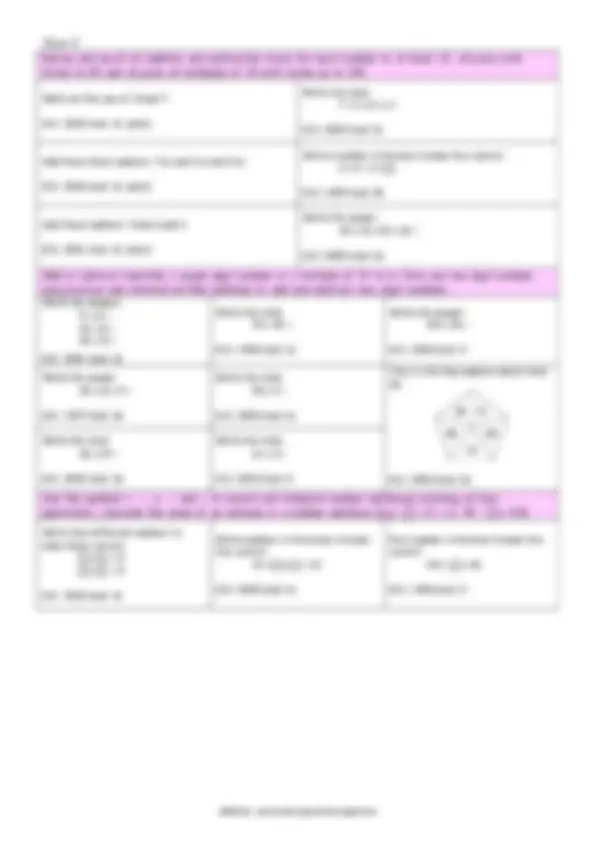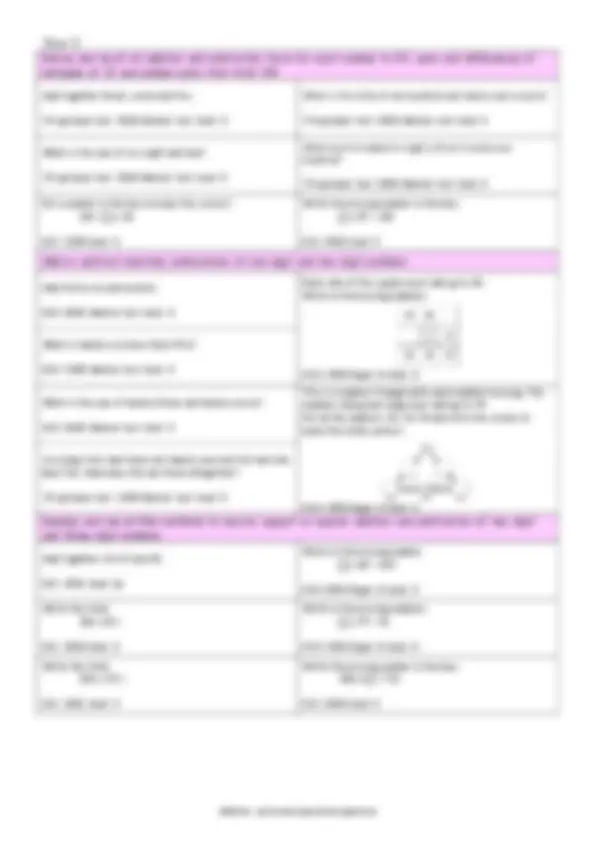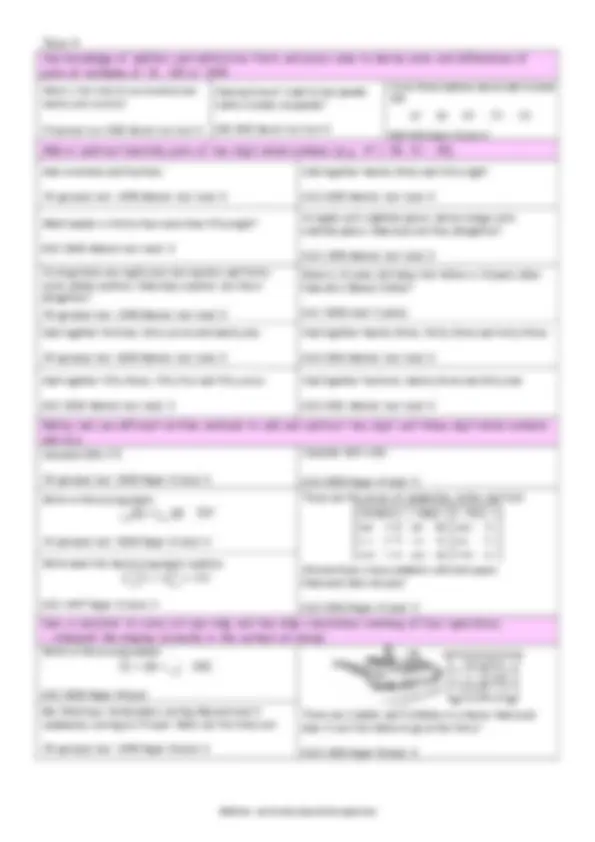





Study with the several resources on Docsity

Earn points by helping other students or get them with a premium plan


Prepare for your exams
Study with the several resources on Docsity

Earn points to download
Earn points by helping other students or get them with a premium plan
Community
Ask the community for help and clear up your study doubts
Discover the best universities in your country according to Docsity users
Free resources
Download our free guides on studying techniques, anxiety management strategies, and thesis advice from Docsity tutors
Addition – pitch and expectation questions. Reception to Yr 1. Observe number relationships and patterns in the environment and use these to derive facts.
Typology: Summaries
1 / 7

This page cannot be seen from the preview
Don't miss anything!




How many fingers are there on two hands? How are the eggs arranged in the egg box? How many eggs are there altogether in the box?
I am going to add one more cube to this set of these four cubes. How many cubes will there be then?
What number is one more than five? You can use the cubes to help you.
Show me five fingers. Use both hands. Show me another way to do it. Find two jackets that have four buttons altogether. Are there any other possibilities? In how many different ways can we put five cakes on two plates?
There are four cups on the table. Put two more cups on the table. How many cups altogether are on the table now? [Count 5 pennies into a purse and shut it. Show 2 more pennies in your hand.] How many pennies are there altogether? We have four easels. There are seven children who want to paint. How many more easels do we need?
Hop three spaces on this number track. Now hop two more. Where are you now? I have two toys in a box. I add four more toys to the box. How many toys are there in the box now? Start with two. Hold it in your head. Count on to five. Show me 5 fingers on one hand. Show me 2 fingers on the other hand. How many fingers altogether? Find all the dominoes that have a total of six spots. Count 5 small toys into this cloth bag. How many objects in the bag? Now count 2 more small toys into the bag. How many small toys in the bag now? How many grey rabbits are there? How many white rabbits are there? How many rabbits are there altogether? I have hidden two cubes in this box. There are three cubes on the table. How many cubes are there altogether? Here are five toy cars. How many more cars are needed to make a set of eight cars?
Write a number in the box to make this correct. 2 + 8 = 6 + KS1 1999 level 2b Look at these cards. Use one card each time to make this correct. KS1 2001 level 2c
Show me your arrow card which has numbers on it that add up to three. Match the arrow card to the number 3 on your strip. Now do the same for the other cards. KS1 1998 level 1 [oral] Add these numbers: 5 and 6 and 2. KS1 2001 level 2c [oral] What is fifty-three add ten? [oral question] What is thirty-seven add five? [oral question] Write the total. 35 + 40 = KS1 1998 level 2c
Buy 2 different comics and spend 16p. Tick the 2 comics. Write an addition to show what you did. KS1 1999 level 1 [oral] Write the total. 7 + 3 + 8 + 2 = KS1 2004 level 2c Write numbers in the shapes to add to 12. + = 12 KS1 1996 level 2c Put a number in the box to make this correct. 3 + + 9 = 17 KS1 1998 level 2b
Add together three, seven and five. Y4 optional test 2003 Mental test level 2 What is the total of one hundred and twenty and seventy? Y4 optional test 2003 Mental test level 3 What is the sum of six, eight and nine? Y3 optional test 2003 Mental test level 3 What must be added to eighty-three to make one hundred? Y3 optional test 2003 Mental test level 3 Put a number in the box to make this correct. 100 = + 42 KS1 1998 level 3 Write the missing number in the box. + 57 = 100 KS1 2002 level 3
Add thirty-six and seventy. KS2 2002 Mental test level 3 Each side of this square must add up to 80. Write in the missing numbers. KS2 1998 Paper A level 3 What is twenty-six more than fifty? KS2 1998 Mental test level 3 What is the sum of twenty-three and twenty-seven? KS2 2000 Mental test level 3 This is a number triangle with some numbers missing. The numbers along each edge must add up to 90 Put all the numbers 20, 30, 50 and 60 in the circles to make the totals correct. KS2 1995 Paper A level 3 In a large fish tank there are twenty-one red fish and nine blue fish. How many fish are there altogether? Y3 optional test 1998 Mental test level 3
Add together 24, 67 and 45. KS1 2001 level 2a Write in the missing number. + 85 = 200 KS2 2004 Paper A level 3 Write the total. 156 + 83 = KS1 2004 level 3 Write in the missing numbers. + 79 = 91 KS2 1996 Paper A level 3 Write the total. 256 + 172 = KS1 2001 level 3 Write the missing number in the box. 456 + = 710 KS1 2003 level 3
What is the total of one hundred and twenty and seventy? Y4 optional test 2003 Mental test level 3 How much must I add to four pounds ninety to make six pounds? KS 2 2003 Mental test level 3 Circle three numbers which add to make 19 0. KS 2 2001 Paper B level 3
Add seventeen and fourteen. Y3 optional test 1998 Mental test level 3 Add together twenty-three and forty-eight. KS2 2005 Mental test level 3 What number is thirty-four more than fifty-eight? KS2 2003 Mental test level 3 An apple costs eighteen pence, and an orange costs nineteen pence. How much are they altogether? KS2 1998 Mental test level 3 In a bag there are eighty-one red counters and thirty- seven yellow counters. How many counters are there altogether? Y5 optional test 1998 Mental test level 3 Emma is 21 years old today. Her father is 24 years older. How old is Emma’s father? KS1 2005 level 3 [oral] Add together thirteen, forty-seven and twenty-one. Y5 optional test 2003 Mental test level 3 Add together twenty-three, thirty-three and forty-three. KS2 2004 Mental test level 3 Add together fifty-three, fifty-five and fifty-seven. KS2 2002 Mental test level 3 Add together fourteen, twenty-three and forty-one KS2 2001 Mental test level 3
Calculate 584 + 79. Y5 optional test 2003 Paper A level 3 Calculate 369 + 251. KS2 2000 Paper A level 3 Write in the missing digits. Y4 optional test 2003 Paper A level 3 These are the prices of sandwiches, drinks and fruit. Shereen buys a tuna sandwich, milk and a pear. How much does she pay? KS2 2004 Paper A level 3 Write what the two missing digits could be. KS2 1997 Paper A level 4
Write in the missing number. KS2 2000 Paper B level There are 2 adults and 3 children in a family. How much does it cost the family to go on the ferry? KS2 1996 Paper B level 3 Mrs Patel buys 4 milkshakes costing 65p each and 3 sandwiches costing £1.70 each. Work out the total cost. Y5 optional test 1998 Paper B level 3
What is the sum of eight point five and eight point six? KS2 2002 Mental test level 4 Add three point five to four point eight. KS2 1999 Mental test level 4 Add together nought point two, nought point four and nought point six. KS2 2005 Mental test level 4 Circle two numbers which add to make 0.12. KS2 2000 Paper A level 4 Circle the two numbers which add up to 1. KS2 1999 Paper A level 5 Tick () the two numbers which have a total of 10. KS2 2005 Paper A level 4 The first two numbers in this sequence are 2.1 and 2.2. The sequence then follows the rule ‘to get the next number, add the two previous numbers‘. Write in the next two numbers in the sequence. KS2 2003 Paper A level 4
Write in the missing digits. KS2 2004 Paper A level 4 In the chart any three numbers in a line, across or down, have a total of 18.45. Write the missing number. KS2 1997 Paper A level 4 Some children go camping. It costs £2.20 for each child to camp each night. They go for 6 nights. How much will each child have to pay for the 6 nights? KS2 1998 Paper A level 4